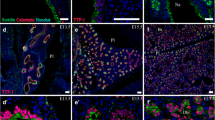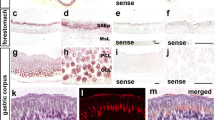Abstract
Recent evidence shows that the serine protease inhibitor Kazal type 3 (Spink3) has more diverse functions than expected. To gain insight into its function, we analyzed the spatiotemporal expression profile of Spink3, using in situ hybridization (ISH) and a Spink3 +/lacZ knock-in mouse, in which lacZ was inserted into the Spink3 locus. Spink3 lacZ expression was first observed in the foregut, midgut, hindgut and the forebrain/midbrain junction region at 9.5 days post coitus (dpc). In the pancreas, Spink3 mRNA was detected at 11.5 dpc, before formation of the typical shape of the exocrine structure of the pancreas. Acinar cell expression was clearly identified by 13.5 dpc. After differentiation of the intestinal tract, Spink3 lacZ expression was observed in the large intestine at 11.5 dpc, followed by expression in the small intestine at 13.5 dpc, before appearance of intestinal digestive enzymes. Spink3 mRNA and Spink3 lacZ activity were also detected in other tissues, including the mesonephric tubules and the urogenital ridge at 11.5 dpc, the genital swelling at 13.5 dpc, the ductus epididymis at 17.5 dpc, and the seminal vesicle at 8 weeks. These data suggest that Spink3 may play important roles in proliferation and/or differentiation of various cell types during development.





Similar content being viewed by others
Abbreviations
- Spink3:
-
Serine protease inhibitor Kazal type 1
- PSTI:
-
Pancreatic secretory trypsin inhibitor
- EGF:
-
Epidermal growth factor
- X-gal:
-
4-Chloro-5-bromo-3-indolyl-β-D-galactopyranoside
- CCK:
-
Cholecystokinin
- ES:
-
Embryonic stem
- ISH:
-
In situ hybridization
- dpc:
-
Days post coitum
- dpp:
-
Days post partum
- DIG:
-
Digoxigenin
- RE:
-
Right element mutant lox site
- TATI:
-
Tumor associated trypsin inhibitor
References
Araki K, Araki M, Yamamura K (2002) Site-directed integration of the Cre gene mediated by Cre recombinase using a combination of mutant lox sites. Nucleic Acids Res 30:e103
Araki K, Araki M, Yamamura K (1997) Targeted integration of DNA using mutant lox sites in embryonic cells. Nucleic Acids Res 25:868–872
Araki K, Imaizumi T, Sekimoto T, Yoshinobu K, Yoshimuta J, Akizuki M, Miura K, Araki M, Yamamura K (1999) Exchangeble gene trap using the Cre/mutated lox system. Cell Mol Biol (Noisy-le-grand) 45:737–750
Freeman TC, Playford RJ, Quinn K, Beardshall K, Calam J (1990a) Pancreatic secretory trypsin inhibitor in gastrointestinal mucosa and gastric juice. Gut 31:1318–1323
Freeman TC, Curry BJ, Calam J, Woodburn J (1990b) Pancreatic secretory trypsin inhibitor stimulates the growth of pancreatic tumor cells. Gastroenterology 99:1414–1420
Fukayama M, Hayashi Y, Koike M, Ogawa M, Kosaki G (1986) Immunohistochemical localization of pancreatic secretory trypsin inhibitor in fetal and adult pancreatic and extrapancreatic tissues. J Histochem Cytochem 34:227–235
Han JH, Rall L, Rutter WJ (1986) Selective expression o rat pancreatic genes during embryonic development. Proc Natl Acad Sci 83:110–114
Jowett T (1997) Tissue in situ hybridization: methods in animal development. Wiley/Spektrum Akademischer Verlag (press), New York
Kazal LA, Spicer DS, Brahinsky RA (1948) Isolation of a crystalline trypsin inhibitor anticoagulant protein from the pancreas. J Am Chem Soc 70:304–340
Kimura S, Niwa H, Moriyama M, Araki K, Abe K, Miike T, Yamamura K (1994) Improvement of germ line transmission by targeting ß-galactosidase to nuclei in transgenic mice. Dev Growth Differ 36:521–527
Kitamoto T, Nakamura K, Nakao K, Shibuya S, Shin RW, Gondo Y, Katsuki M, Tateishi J (1996) Humanized prion protein knock-in by Cre-induced site-specific recombination in the mouse. Biochem Biophys Res Commun 222:742–747
Kolb AF (2001) Selection-marker-free modification of the murine β-casein gene using a lox 2272 (correction of lox2722) site. Anal Biochem 290:260–271
Koshikawa N, Hasegawa S, Nagashima Y, Mitsuhashi K, Tsubota Y, Miyata S, Miyagi Y, Yasumitsu H, Miyazaki K (1998) Expression of trypsin by epithelial cells of various tissues, leukocytes, and neurons in human and mouse. Am J Pathol 153:937–944
Lukkonen A, Lintula S, Boguslawski KV, Carpèn O, Lgungberg B, Landberg G, Stenman UH (1999) Tumor-associated trypsin inhibitors in normal and malignant renal tissue and in serum of renal cell carcinoma patients. Int J Cancer 83:486–490
Marchbank T, Chinery R, Hanby AM, Poulsom R, Elia G, Playford RJ (1996) Distribution and expression of pancreatic secretory trypsin inhibitor and its possible role in epithelial restitution. Am J Pathol 148:715–722
Marchbank T, Freeman TC, Playford RJ (1998) Human pancreatic secretory trypsin inhibitor. Digestion 59:167–174
Marchetti S, Gimond C, Iljin K, Bourcier C, Alitalo K, Pouysségur J, Pagès G (2002) Endothelial cells genetically selected from differentiating mouse embryonic stem cells incorporate at sites of neovascularization in vivo. J Cell Sci 115:2075–2085
McKeenan WL, Sakagami Y, Hoshi H (1986) Two apparent human endothelial cell growth factors from hepatoma cells are tumor-associated proteinase inhibitors. J Biol Chem 261:5378–5383
Niinobu T, Murata A, Nishijima J, Mori T (1990) Identification and characterization of receptors specific for human pancreatic secretory trypsin inhibitor. J Exp Med 172:1133–1142
Ogawa M, Tsushima T, Ohba Y (1985) Stimulation of DNA synthesis in human fibroblasts by human pancreatic secretory trypsin inhibitor. Res Commun Chem Pathol Pharmacol 50:155–158
Ohmuraya M, Hirota M, Araki M, Mizushima N, Matsui M, Mizumoto T, Kyoko H, Kume S, Takeya M, Ogawa M, Araki K, Yamamura K (2005) Autophagic cell death of pancreatic acinar cells in serine protease inhibitor Kazal type 3-deficient mice. Gastroenterology 129:696–705
Ohmuraya M, Hirota M, Araki M, Baba H, Yamamura K (2006) Enhanced trypsin activity in pancreatic acinar cells deficient for serine protease inhibitor Kazal Type 3. Pancreas 33:104–106
Preeti M. Ismail P, Li J, DeMayo FJ, O’Mally BW, Lydon JP (2002) A novel lacZ reporter mouse reveals complex regulation of the progesterone receptor promotor during mammary gland development. Mol Endocrinol 16:2475–2489
Playford RJ, Hanby AM, Quinn C, Calam J (1994) Influence of inflammation and atrophy on pancreatic secretory trypsin inhibitor levels within the gastric mucosa. Gastroenterology 106:735–741
Sadler TW (2006) Langman’s medical embryology, 10th edn. RR Donnelley & Sons Company (press), Chicago
Scheving LA (1983) Primary amino acid sequence similarity between human epidermal growth factor-urogastrone, human pancreatic secretory trypsin inhibitor and members of the porcine secretin family. Arch Biochem Biophys 226:411–413
Senior PV, Critchley DR, Beck F, Walker RA, Varley JM (1988) The localization of lamin mRNA and protein in the postimplantation embryo and placenta of the mouse: an in situ hybridization and immunohistochemical study. Development 104:431–446
Sherwood RI, Jitianu C, Cleaver O, Shaywitz DA, Lamenzo JO, Chen AE, Golub TR, Melton DA (2007) Prospective isolation and global gene expression analysis of definitive and visceral endoderm. Dev Biol 304:541–555
Shibata T, Ogawa M, Matsuda K, Miyauchi K, Yamamoto T, Mori T (1986) Purification and characterization of pancreatic secretory trypsin inhibitor in human gastric mucosa. Clin Chim Acta 159:27–36
Theiler K (1989) The House mouse: atlas of embryonic development, 1st edn. Arcata Graphics/Halliday (press), West Hanover
Thomson JG, Rucker EB 3rd, Piedrahita JA (2003) Mutational analysis of loxP sites for efficient Cre-mediated insertion into genomic DNA. Genesis 36:162–167
Thomas GS, William JR (1974) The developmental regulation of Amylolytic and proteolytic enzymes in the embryonic rat pancreas. J Biol Chem 249:3500–3509
Yagi T, Tokunaga T, Furuta Y, Nada S, Yoshida M, Tsukada T, Saga Y, Takeda N, Ikawa Y, Aizawa S (1993) A novel ES cell line, TT2, with high germline-differentiating potency. Anal Biochem 214:70–76
Yu J, McMahon AP, Valerius MT (2004) Recent genetic studies of mouse kidney development. Curr Opin Genetics Dev 14:550–557
Van Nest GA, MacDonald RJ, Raman RK, Rutter WJ (1980) Proteins synthesized and secreted during rat pancreatic development. J Cell Biol 86:784–794
Acknowledgments
We sincerely appreciate Mrs. Michiyo Nakata for her excellent work on tissue section preparation. We would like also to show our thanks to Mr. Ryo Yamashita for his valuable advice on the X-gal staining technique. This work was supported, in part, by KAKENHI (Grant-in-Aid for Scientific Research) in Priority Areas “Integrative Research Toward the Conquest of Cancer” and a Grant-in-Aid for Young Scientists (B) from the Ministry of Education, Culture, Sports, Science, and Technology of Japan, a grant from the Osaka Foundation for the Promotion of Clinical Immunology and a grant from the Pancreas Research Foundation of Japan.
Author information
Authors and Affiliations
Corresponding author
Additional information
This work was supported, in part, by KAKENHI (Grant-in-Aid for Scientific Research) in Priority Areas “Integrative Research Toward the Conquest of Cancer” and by a Grant-in-Aid for Young Scientists (B) from the Ministry of Education, Culture, Sports, Science, and Technology of Japan, a grant from the Osaka Foundation for the Promotion of Clinical Immunology and a grant from the Pancreas Research Foundation of Japan.
Rights and permissions
About this article
Cite this article
Wang, J., Ohmuraya, M., Hirota, M. et al. Expression pattern of serine protease inhibitor kazal type 3 (Spink3) during mouse embryonic development. Histochem Cell Biol 130, 387–397 (2008). https://doi.org/10.1007/s00418-008-0425-8
Accepted:
Published:
Issue Date:
DOI: https://doi.org/10.1007/s00418-008-0425-8




